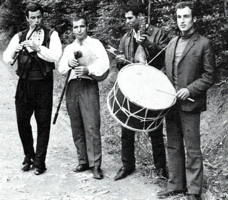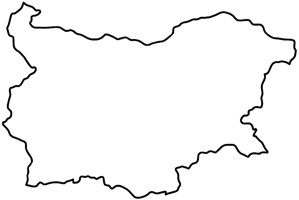
|
The Society of Folk Dance Historians (SFDH)
The Origin of the Folk Orchestra in Bulgaria
[
Home |
About |
Encyclopedia | CLICK AN IMAGE TO ENLARGE |

|
 Before I had ever been to Bulgaria, I was giving a lecture on Bulgarian folk music when someone asked if orchestras of folk instruments were traditional. I unhesitatingly answered, "Yes, they are," and tried to recover my train of thought and continue the lecture that I had planned.
Before I had ever been to Bulgaria, I was giving a lecture on Bulgarian folk music when someone asked if orchestras of folk instruments were traditional. I unhesitatingly answered, "Yes, they are," and tried to recover my train of thought and continue the lecture that I had planned.
The question stuck in my mind, though, and I found myself wondering more and more just what the status was of these orchestras with four or five folk instruments – gaida, kaval, gadulka, tambura, and tapan – that are heard so often in Bulgaria today. Since then, I have done field work and some reading and tried to reconstruct in a casual way the history of the use of folk instruments in Bulgaria.
The oldest use of instruments in Bulgaria was in a solo capacity – a shepherd amusing himself on the kaval during the long months away from home, or a lone gaida musician playing for a dance. In those days an instrument was made by the man who played it according to a simple "rule of thumb." The result was an instrument that was pleasing to look at and that fit the hand comfortably, but which did not meet any particular pitch standard, because there probably was none. Unless two wind instruments were made by exactly the same rule of thumb and with the same thumb, they could not be played together because they would sound at completely different pitches. If we would to hear one of these instruments today, we would be impressed with how "out-of-tune" it sounded. In fact, a player probably got so accustomed to the way his own instrument sounded that he would have regarded someone else's instrument as "out-of-tune." In other words, there were individual pitch standards, but no common, generally agreed upon pitch standard such as the tempered scale embodied in the piano today.
The first "orchestras" probably consisted of only two "voices" – an epic ballad singer accompanying himself on gadulka, a pair of kavals made by the same shepherd in the Pirin region, or a gaida and tapan being played for a dance. After this, however, the picture gets rather hazy. Logically, the next thing that happened was that a number of stringed instruments, that are easily tunable, combined with a tapan to play for dances. there is a photograph, for example, of four gadulkas and two tapans playing for a dance in North Bulgaria in 1892. The next step probably was that one or more stringed instruments combined with one wind instrument because the former could easily tune themselves to the latter. Gaida or kaval and gadulka are certainly found frequently today in Thrace, for example. The problem is that we do not know even roughly when this first happened. It could have been three hundred years ago or as little as forty years ago.
Today, there is an orchestra made up of one or more of each of these instruments in every town and in many of the villages of Bulgaria. I will never forget the thrill I felt when I happened on a wedding in a village in Thrace where an orchestra of two kavals, gadulka, gaida, and tapan was being played. At the time, it all seemed perfectly natural and wonderful and beautiful, and it still does. But now I wonder whether I would have found such an orchestra had I attended a wedding in that village fifty years earlier. I seriously doubt it.
I lived with a well-known family of musicians in the village of Bistrica near Sofia, and this is the story that they told about how the first such orchestra was formed. Every year a group of koledari (male Christmas carolers) from Bistrica made the rounds of Sofia and Plovdiv, and wherever they sang, they would be given food and drink and some money. Accompanying the group were musicians who played all of the basic folk instruments, but they had never played them together. One would play alone while the rest of the group danced. His place would be taken by a second musician, and the first would join the dancers for the next dance. During the Christmas season of 1935, these koledari were in Plovdiv, when a Bulgarian singer from the Plovdiv Opera happened to observe their activities. When he realized that there were three of four instrumentalists present, he asked them why they did not play together. They answered that they had never thought of it, and he suggested that they try it, that it might sound quite interesting.
They returned to Bistrica, mulled over the suggestion, and decided to try it. The major problem was how to get their instruments to play "in tune" with one another. They worked for the greater part of six months on the problem before they manufactured four instruments on which they all could play the same melody at the same pitch. They claimed that this was the first time that all four of the major Bulgarian folk instruments had played together as an orchestra.
The four men called themselves the Bistriška Četvorka (Bistrica Foursome) and they were not only talented musicians, but dancers, singers, and storytellers as well. They could put on a complete show, and by all accounts, were the very apotheosis of Šop dancing. On one occasion, they were performing in Germany on an outdoor stage. After playing a few numbers, three of them put down their instruments and danced, while the fourth played for them. They ended one of their dances by leaping into the air and coming down squarely on both feet. On this occasion, the stage caved in, and to the delight of the audience, only their heads and shoulders protruded above the stage floor. Bistričani, of course, have a saying about this sort of thing, "Beware, Mother Earth, for a Šop is treading on you!"
The Bistriška Četvorka was an overnight sensation, and soon had their own live show over Radio Sofia. Their playing had a stunning effect, and the whole city would virtually come to a standstill to listen to their music. In the same year, 1936, a group from Thrace was formed that included gaida, kaval and gadulka. In 1939, two other groups began to play for Radio Sofia. One was called Trakiska Grupa (Thracian Group), made up of kaval, gadulka, and tambura with some of the same musicians from the earlier Thracian group. The other was called Ugarčinska Grupa (Group from Ugarčin, a town in North Bulgaria) and included all four instruments plus tapan. Some of the musicians in these latter two groups formed the nucleus of the first large orchestra of folk instruments at Radio Sofia after the Second World War, and the tunes and dances of the Bistriška Četvorka became an important part of the early repertoire of the National Ensemble of Folk Songs and Dances, organized under the direction of Philip Kutev.
Whether or not it is literally true that the Bistriška Četvorka was the first group to use all of the basic Bulgarian folk instruments in an orchestra, the story is interesting because it illustrates what happened in at least one village. These villagers did not take their example directly from the brass band and café orchestra played on western instruments that they undoubtedly had heard. Even after hearing western instrument played in orchestras, they continued to play their traditional instruments traditionally, that is, alone and unaccompanied. It took the intervention and suggestion of a fellow Bulgarian, but one who was essentially the bearer of a different tradition, to implant this new idea, the idea of an orchestra, in their midst.
DOCUMENTS
Used with permission of the
Center for Traditional Music and Dance Archive, www.ctmd.org.
Printed in Balkan-Arts Traditions, 1974.
This page © 2018 by Ron Houston.
Please do not copy any part of this page without including this copyright notice.
Please do not copy small portions out of context.
Please do not copy large portions without permission from Ron Houston.